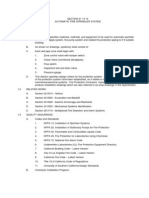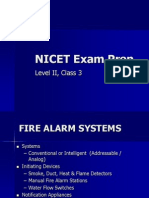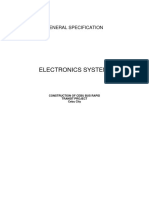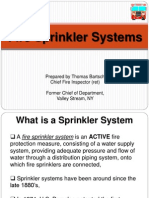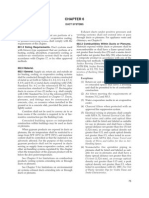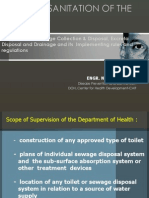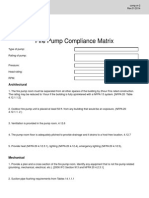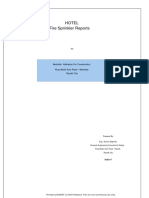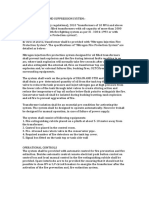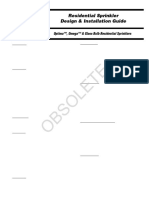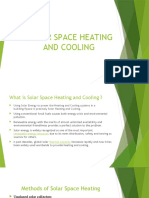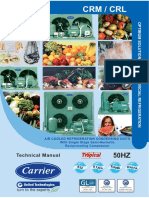Fire Sprinkler Distance Rules
Fire Sprinkler Distance Rules
Uploaded by
Jherson GravidesCopyright:
Available Formats
Fire Sprinkler Distance Rules
Fire Sprinkler Distance Rules
Uploaded by
Jherson GravidesOriginal Description:
Copyright
Available Formats
Share this document
Did you find this document useful?
Is this content inappropriate?
Copyright:
Available Formats
Fire Sprinkler Distance Rules
Fire Sprinkler Distance Rules
Uploaded by
Jherson GravidesCopyright:
Available Formats
Fire Sprinkler Distance Rules
By Victoria Smoothens
Every state has different laws governing the positioning of fire sprinklers, but all states
must follow certain federal laws. Federal law states that fire sprinklers must be
positioned and located to provide satisfactory performance in terms of activation time
and distribution. Sprinklers can have different clearance requirements from structural
members and ceilings if they are specifically tested to show that their ability to sense,
control and suppress a fire is not impaired.
Maximum Protection Area Per Sprinkler
Sprinklers cannot exceed the maximum protection area per sprinkler. According to the
National Fire Protection Associations Standard for the Installation of Sprinkler Systems
2010 Edition, the specific formula for determining the protection area of coverage per
sprinkler -- where A1 is the protection area -- is A1 = S x L. S is defined as whichever is
larger: either twice the distance between sprinkler to sprinkler or between sprinkler and
a wall or obstruction, upstream and downstream. L is defined as whichever is larger: the
perpendicular distance to the sprinkler on the adjacent branch line, or the perpendicular
distance between the sprinkler and a wall or obstruction.
Sponsored link
Free Download
Get OfficeX and never pay for office software again.
officex.org
Maximum and Minimum Sprinkler Distance
Section 8.5.2.2.2 states that the maximum sprinkler coverage area shall not exceed 400
square feet. The standard also states that the maximum distance between sprinklers is
based on the centerline distance between adjacent sprinklers and shall be measured
along the slope of the ceiling. Sprinkler distance to a wall cannot exceed one-half of the
maximum distance between sprinklers. The distance from the wall to the sprinkler is
measured perpendicular to the wall behind furniture. The minimum distance between
sprinklers should prevent operating sprinklers from wetting adjacent sprinklers and
prevent sprinkler skipping.
Sprinkler Distance from Heating Ducts and Unit
Heaters
Sprinklers of ordinary and intermediate temperature must be located more than 2 feet, 6
inches above a heating duct and uncovered steam main, and more than 1 foot to the
side and below. Sprinklers of an ordinary temperature located adjacent to a heating duct
discharging air less than 100 degrees F do not have to be separated according to these
rules. High-temperature sprinklers must be located in a seven-foot radius cylinder
extending seven feet above and 2 feet below a unit heater with horizontal discharge.
Sprinkler Distance from Other Heat Sources
Section 8.3.2.5 states that sprinklers located within 12 inches to one side or 30 inches
above an uncovered radiator, steam main or heating coil are classified as intermediate-
temperature. Sprinklers within 7 feet of a low-pressure blowoff valve discharging free in
a large room are classified as high-temperature. Table 8.3.2.5(c) shows that ordinary-
temperature sprinklers must be located at least 36 inches from the side of an open or
recessed fireplace; 60 inches from the front of a recessed fireplace; 42 inches from a
coal or wood-burning stove; 18 inches from a kitchen range, wall oven, hot air flue or
uninsulated heat duct; 12 inches from an uninsulated hot water pipe; 24 inches from the
side of a ceiling or wall-mounted hot air diffuser; 36 inches from the front of a wall-
mounted hot air diffusers; 6 inches from a hot water heater or furnace; 6 inches from a
light fixture from 0 W to 250 W and 12 inches from a light fixture from 250 W to 499 W.
These measurements are generally less for intermediate-temperature sprinklers.
Sponsored links
Sprinkler Head Spacing and
Location
***WARNING: Fire suppression systems, including sprinklers, MUST be
designed by a Professional Engineer. The information contained in this article
is general in nature and is to be used as a GUIDELINE for architects. You must
have a Professional Engineer design a sprinkler system to address your
specific situation and to meet the codes applicable in your jurisdiction. The
information in the article is based on NFPA 13.
Sprinkler Head Location
There are two main criteria for the location of sprinkler heads. First, sprinklers must be
located so they are within the hot-gas layer that develops near the ceiling during a fire
because activation occurs when the sprinkler head reaches a certain temperature.
Second, they must be located so that the water that is discharged from the sprinkler is
not disrupted or affected by construction elements such as beams, trusses, or soffits.
The diagram at left shows the water distribution for standard pendant and upright
sprinkler fixtures. It is useful to understand how objects within this distribution area can
alter the throw and disrupt the ability of the sprinkler to extinguish a fire.
This is a general depiction of sprinkler throw and should not be used to determine
sprinkler spacing. Refer to the manufacturer data for specific throw data. Please note,
that the throw of a sprinkler should not be used for sprinkler spacing - local codes
determine spacing requirements.
Ad - Article Contin
Sprinkler Head Spacing
The table below shows sprinkler spacing requirements based on NFPA 13. This table
shall be used only as a tool for architects. Actual design of a sprinkler system MUST be
done by a Professional Engineer for each project.
MAXIMUM
SQUARE SPACING
FOOT PER BETWEEN
OCCUPANCY HAZARD HEAD SPRINKLERS
Light Hazard 130-200 SF per 15 ft
(Office, Educational, Religious, Institutional, head
Hospitals, Restaurants, Clubs, Theaters, etc.) (based on
obstructions and
flow calcs)
Ordinary Hazard 130 SF per head 15 ft
(Mills, Manufacturing, Processing, Machine Shops,
Repair Garages, Post Offices, Bakeries, Wood
Machining and Assembly, Auto Parking, etc.)
Extra Hazard 90-130 SF per 12 ft
(Plastic Processing, Chemical Spraying, Metal head
Extruding, Printing, Varnishing, Painting, etc.) (based on
obstructions and
flow calcs)
Maximum Distance from Wall: half (1/2) of the maximum distance between sprinkler
heads.
Minimum Distance Between Sprinklers: typically 6'-0".
Distance from Ceiling: minimum 1", maximum 12" for unobstructed construction. The
minimum 1" is typical; however, concealed, recessed, and flush sprinklers may be
mounted less than 1" from the ceiling and shall be installed based on their listing.
You might also like
- Everything About Elite Fire Software PDFDocument71 pagesEverything About Elite Fire Software PDFSalMa100% (1)
- VESDA Commissioning Forms VLP Rev01Document7 pagesVESDA Commissioning Forms VLP Rev01Femi Dele100% (1)
- Nfpa 14 Standpipes & Hose Valves: Presented by American Fire Sprinkler AssociationDocument34 pagesNfpa 14 Standpipes & Hose Valves: Presented by American Fire Sprinkler Associationhesham3bbasNo ratings yet
- 04 05 PME Write ShopDocument3 pages04 05 PME Write Shopjamil diligNo ratings yet
- Maintenance ManualDocument16 pagesMaintenance ManualAbdul HakkimNo ratings yet
- Kitchen Fire Suppression SystemsDocument47 pagesKitchen Fire Suppression Systemszhobeys100% (2)
- New Mandated Falar 1-3Document4 pagesNew Mandated Falar 1-3MICHAEL TANNo ratings yet
- Duct SystemsDocument32 pagesDuct SystemsJherson GravidesNo ratings yet
- Refrigeration & Air Conditioning - Stoecker & JonesDocument440 pagesRefrigeration & Air Conditioning - Stoecker & JonesJherson Gravides100% (1)
- Fogel User GuideDocument8 pagesFogel User GuideJBESNo ratings yet
- 7 Hose Reel SystemDocument5 pages7 Hose Reel SystemTian Fung Wang100% (3)
- Volume 1 Fire Protection Systems Testing and Commissioning ProceduresDocument7 pagesVolume 1 Fire Protection Systems Testing and Commissioning ProceduresAbdalrahman AntariNo ratings yet
- Foam Suppression SystemDocument19 pagesFoam Suppression Systemansar thowfeekNo ratings yet
- Guide To Professional Mechanical Engineering ApplicationDocument2 pagesGuide To Professional Mechanical Engineering ApplicationJoemar AnchetaNo ratings yet
- Automatic Fire Sprinkler SystemDocument16 pagesAutomatic Fire Sprinkler SystemArnel ArnaoNo ratings yet
- Combination Standpipe - Sprinkler Risers - Nfpa PDFDocument10 pagesCombination Standpipe - Sprinkler Risers - Nfpa PDFodemircioglu2No ratings yet
- Component of Fire Sprinkler SystemDocument2 pagesComponent of Fire Sprinkler SystemFaeez Zain100% (2)
- CTV PRC007M en - 09152015Document40 pagesCTV PRC007M en - 09152015razali131266100% (1)
- Is - 15105 - Sprinkler SystemDocument60 pagesIs - 15105 - Sprinkler Systemmech_iimm50% (2)
- Fire Sprinkler System NFPA 13 Plan Review Checklist PDFDocument10 pagesFire Sprinkler System NFPA 13 Plan Review Checklist PDFAshik HasanNo ratings yet
- Fpe Cwsi Wireless Fire Alarm SystemsDocument43 pagesFpe Cwsi Wireless Fire Alarm SystemsRandy BjorensenNo ratings yet
- Wet Chemical Kitchen Fire Suppression SystemDocument5 pagesWet Chemical Kitchen Fire Suppression SystemQuach Huy Hai100% (1)
- Fire Alarm Sequence of EventsDocument1 pageFire Alarm Sequence of Eventstechnomurali100% (1)
- FACP, Presentation Level II Class 3Document46 pagesFACP, Presentation Level II Class 3Salley BukhariNo ratings yet
- Fire Alarm SpecificationsDocument13 pagesFire Alarm SpecificationsDyeri FloresNo ratings yet
- Smoke Control System DesignDocument4 pagesSmoke Control System DesignHermi David100% (1)
- 12.0 - Inspection Testing & CommissioningDocument17 pages12.0 - Inspection Testing & CommissioningAmando Gonzales100% (1)
- Fire Sprinkler SystemsDocument83 pagesFire Sprinkler Systemsdheerajdorlikar100% (1)
- Automatic Fire Sprinkler SystemDocument35 pagesAutomatic Fire Sprinkler SystemAnandababuNo ratings yet
- 2005.04 Hydraulic Calculation of Wet and Dry Risers, Hoses ADocument56 pages2005.04 Hydraulic Calculation of Wet and Dry Risers, Hoses AEjaz Ahmed RanaNo ratings yet
- NF Pa 13 Acceptance TestDocument4 pagesNF Pa 13 Acceptance Testaxl1No ratings yet
- Fire Sprinkler SystemsDocument83 pagesFire Sprinkler SystemsJaime Alberto Villarreal100% (1)
- Testing and Commissioning of Water Booster Pump Set Method Statement PDFDocument3 pagesTesting and Commissioning of Water Booster Pump Set Method Statement PDFHumaid ShaikhNo ratings yet
- Uniform Mechanical Code - 2009 Chapter 6Document14 pagesUniform Mechanical Code - 2009 Chapter 6memosplumbing100% (1)
- For 500 GPM CalDocument56 pagesFor 500 GPM CalNeal JohnsonNo ratings yet
- MEP Fire Protection RevDocument64 pagesMEP Fire Protection Revmeeng2014No ratings yet
- To Ensure Sprinkler System InstallationsDocument20 pagesTo Ensure Sprinkler System Installationsspecial_nazNo ratings yet
- Key Factors To Select FAHU: A Transfer of Knowledge & Expertise ....Document1 pageKey Factors To Select FAHU: A Transfer of Knowledge & Expertise ....Alihassan100% (1)
- IRR On Proper Sewage HandlingDocument51 pagesIRR On Proper Sewage HandlingDexter G. BatalaoNo ratings yet
- Fire Pump Compliance MatrixDocument5 pagesFire Pump Compliance Matrixshakil612No ratings yet
- BOQ Format - Fire Pro PDFDocument6 pagesBOQ Format - Fire Pro PDFKurama BasketNo ratings yet
- Elite Hydraulic Calculation SampleDocument12 pagesElite Hydraulic Calculation SampleSam Choi75% (4)
- Fire Protection and Suppression SystemDocument4 pagesFire Protection and Suppression Systemamrit90320No ratings yet
- Full Sprinkler SpecificationDocument22 pagesFull Sprinkler Specificationmakmak9100% (1)
- WAVIN HDPE BOOKLET - Lowres Proof PDFDocument35 pagesWAVIN HDPE BOOKLET - Lowres Proof PDFTANASEGMIHAINo ratings yet
- Hose Stream Demands - Part 1Document4 pagesHose Stream Demands - Part 1Sergio Garro100% (1)
- Chapter 7 - Mechanical Ventilation and Smoke Control SystemsDocument24 pagesChapter 7 - Mechanical Ventilation and Smoke Control Systemsyunying21No ratings yet
- NFPA13RDocument28 pagesNFPA13RAnoj ApNo ratings yet
- Automatic Fire Extinguishing Systems For Commercial Cookingfire Extinguishing Systems For Commercial CookingDocument63 pagesAutomatic Fire Extinguishing Systems For Commercial Cookingfire Extinguishing Systems For Commercial CookingAlex Chin0% (1)
- Canute - Fire Sprinkler Hydraulic CalculationsDocument3 pagesCanute - Fire Sprinkler Hydraulic CalculationsEdgardo Escobar100% (1)
- The Fire Code of The Philippines 2008Document12 pagesThe Fire Code of The Philippines 2008Pete PinonNo ratings yet
- Engineering Solutions For Fire Truck AccesDocument21 pagesEngineering Solutions For Fire Truck AccesRizalNo ratings yet
- FDAS Firepro Hydraulic CalcsDocument187 pagesFDAS Firepro Hydraulic CalcsReymart Manablug100% (1)
- Supply and Installation of Firefighting and Protection System For Berth B100 Part 1Document513 pagesSupply and Installation of Firefighting and Protection System For Berth B100 Part 1Mehmet DurmazNo ratings yet
- Smoke Control Commissioning 9 07Document4 pagesSmoke Control Commissioning 9 07ahmed fouadNo ratings yet
- Fire Sprinkler System Installation RequirementsDocument3 pagesFire Sprinkler System Installation RequirementsLai Huynh VanNo ratings yet
- Fire Sprinkler Head Spacing and Location - ArchtoolboxDocument5 pagesFire Sprinkler Head Spacing and Location - Archtoolboxmoise laurentiuNo ratings yet
- Sprinkler Head TypesDocument7 pagesSprinkler Head TypesWarry SolivenNo ratings yet
- Fire Alarm System reading note 2 ADocument97 pagesFire Alarm System reading note 2 AVicky ViratNo ratings yet
- Hand BooksDocument32 pagesHand BooksRIYAAAZNo ratings yet
- Central Residential Design Guide 06 1996 OBSOLETEDocument12 pagesCentral Residential Design Guide 06 1996 OBSOLETELevan GabedavaNo ratings yet
- How Do Sprinkler Heads WorkingDocument7 pagesHow Do Sprinkler Heads WorkingAnonymous ynJByUsNo ratings yet
- Type D3 MV Sprayer 1Document4 pagesType D3 MV Sprayer 1lavascudoNo ratings yet
- Letter of Extension FDAS PULSERDocument1 pageLetter of Extension FDAS PULSERJherson GravidesNo ratings yet
- Cold Storage Layout1Document1 pageCold Storage Layout1Jherson GravidesNo ratings yet
- Manu FacDocument3 pagesManu FacJherson GravidesNo ratings yet
- Sieving MachineDocument2 pagesSieving MachineJherson Gravides100% (2)
- Vision Joshua 1 8 Rev2016 NatopDocument3 pagesVision Joshua 1 8 Rev2016 NatopJherson GravidesNo ratings yet
- A Detailed Lesson Plan in Science 3Document5 pagesA Detailed Lesson Plan in Science 3Jherson GravidesNo ratings yet
- Water SupplyDocument71 pagesWater SupplyJherson GravidesNo ratings yet
- Pangasinan State UniversityDocument1 pagePangasinan State UniversityJherson GravidesNo ratings yet
- D Rac002.01a Psychrometrics 01 (Of4) r1 (Read Only)Document51 pagesD Rac002.01a Psychrometrics 01 (Of4) r1 (Read Only)Naveen KumarNo ratings yet
- Knowledge and Understanding of HVAC Systems and A&ID'sDocument2 pagesKnowledge and Understanding of HVAC Systems and A&ID'sbestinkallelyNo ratings yet
- Vapour Compression - 1Document1 pageVapour Compression - 1kdpmansiNo ratings yet
- Small Absorption ChillersDocument2 pagesSmall Absorption ChillersAdil AbdoNo ratings yet
- Corrigo C SeriesDocument56 pagesCorrigo C SeriesBertrand herveNo ratings yet
- Hot Water Applications in Residential, Commercial & Industrial SectorsDocument19 pagesHot Water Applications in Residential, Commercial & Industrial SectorsRaghvendra AgarwalNo ratings yet
- Air Conditioning Plant (BSME 5B)Document128 pagesAir Conditioning Plant (BSME 5B)Marvin ArnaizNo ratings yet
- Part 3 Phase Change of The Refrigerant in The CycleDocument7 pagesPart 3 Phase Change of The Refrigerant in The CycleKenneth JameroNo ratings yet
- Solar Space Heating and CoolingDocument14 pagesSolar Space Heating and CoolingGiri Shankar GSBSNo ratings yet
- CHI - BRE - YVAA Air Cooled ChillersDocument8 pagesCHI - BRE - YVAA Air Cooled ChillersluxusNo ratings yet
- Samsung Multi Zone System ComponentsDocument8 pagesSamsung Multi Zone System Componentse-ComfortUSANo ratings yet
- S.C.D R.C.D Split W.M Unit RLBG SLBG RLD SLD Cassette 18,000BTUDocument1 pageS.C.D R.C.D Split W.M Unit RLBG SLBG RLD SLD Cassette 18,000BTUHossam AhmedNo ratings yet
- DCMM Maintenance 2015 CoolingDocument1 pageDCMM Maintenance 2015 CoolingHarumNo ratings yet
- TE 2008 Nov-Dec 2013Document182 pagesTE 2008 Nov-Dec 2013prateekg92No ratings yet
- Yutaki S80 Data SheetDocument2 pagesYutaki S80 Data SheetVishal KhiroyaNo ratings yet
- Five Factors That Effect The Thermal ComfortDocument7 pagesFive Factors That Effect The Thermal ComfortRupal PachauriNo ratings yet
- PIR492-AC-213 - Rev.Z - Room Thermostat List - 20160906Document3 pagesPIR492-AC-213 - Rev.Z - Room Thermostat List - 20160906shantaNo ratings yet
- AHRI 880 Performance Rating of Air TerminalsDocument16 pagesAHRI 880 Performance Rating of Air TerminalsDumitru Cristina100% (1)
- Department of Mechanical Engineering Refrigeration & Air Conditioning Lab Vapour Compression Unit AimDocument7 pagesDepartment of Mechanical Engineering Refrigeration & Air Conditioning Lab Vapour Compression Unit AimGaurav KhamesraNo ratings yet
- Wall Mounted: Split Type Room Air ConditionerDocument19 pagesWall Mounted: Split Type Room Air ConditionerСергей ВеретенниковNo ratings yet
- About Heat PumpsDocument4 pagesAbout Heat Pumpssumit gulatiNo ratings yet
- TDP-502 Water Piping and PumpsDocument64 pagesTDP-502 Water Piping and PumpsAsyifa Aldana100% (1)
- VanOrshoven1991 PDFDocument128 pagesVanOrshoven1991 PDFDiether RigorNo ratings yet
- We Deliver Ice Builders (Latent Heat Storage Units) To The HVAC, Dairy, and Food Processing IndustriesDocument4 pagesWe Deliver Ice Builders (Latent Heat Storage Units) To The HVAC, Dairy, and Food Processing IndustriesArlex Ricardo Guillen PetitNo ratings yet
- CSSD, Hospital HVAC Design Manual 2008Document9 pagesCSSD, Hospital HVAC Design Manual 2008Ahmed ZahyNo ratings yet
- Carrier Cold Room Condensing UnitsDocument52 pagesCarrier Cold Room Condensing Unitsomer samaniNo ratings yet
- RacDocument22 pagesRachelmyNo ratings yet
- bs3 - UNIT 1,2&3Document108 pagesbs3 - UNIT 1,2&3Saran T SNo ratings yet
- Basic Operation of The SystemDocument23 pagesBasic Operation of The SystemBARNABAS DOGO100% (1)














